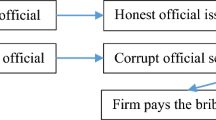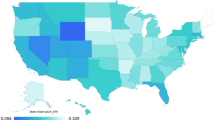Abstract
This study examines the relationship between firm-level tax evasion and corruption. The literature has considered the corruption-firm tax evasion nexus to some extent, however, the heterogeneous impact of bribes on tax evasion has been largely ignored. We posit that the impact of bribes on tax evasion is conditional on the prevalence of tax evasion. Using firm-level information from the Business Environment and Enterprise Performance Survey (BEEPS) across 25 transition economies for the years 2002 and 2005, we estimate the heterogeneous impact of bribes on tax evasion using the censored quantile instrumental variables technique. The results show that corruption has a larger impact when tax evasion is more widespread. Among other results, firm-level characteristics also show heterogeneous effects across the conditional distribution of tax evasion. In terms of the policy implications, the results suggest that policies that focus on reducing the tax burden and controlling corruption will be more effective when tax evasion is more prevalent.
Similar content being viewed by others
Notes
Notice that the phrasing of the question on tax evasion and bribery refers to a typical firm as opposed to your firm, which should help mitigate, at least to some degree, concerns of dishonesty.
For more details on the CQIV technique see Kowalski (2016).
See Eqs. 2.1, 2.2 and 2.3 in Chernozhukov et al. (2015).
As an example, Kowalski (2016) provided a recent application of the CQIV estimator with respect to the estimation of the price elasticity of medical care expenditures and allowed this estimate to vary across the distribution of medical care expenditures while also accounting for endogeneity and censoring. The results suggest that price elasticity varies significantly across the conditional distribution of medical expenditures and highlights the importance of accounting for this heterogeneity, which has important policy implications.
References
Abdixhiku, L., Krasnigi, B., Pugh, G., & Hashi, I. (2017). Firm-level determinants of tax evasion in transition economies. Economic Systems, 41(3), 354–366.
Allingham, M., & Sandmo, A. (1972). Income tax evasion: A theoretical analysis. Journal of Public Economics, 1(3–4), 323–338.
Alm, J. (2012). Measuring, explaining, and controlling tax evasion: Lessons from theory, experiments, and field studies. International Tax and Public Finance, 19(1), 54–77.
Alm, J., & Martinez-Vazquez, J. (2003). Institutions, paradigms, and tax evasion in developing and transition countries. In J. Alm & J. Martinez-Vazquez (Eds.), Public finance in developing and transitional countries – Essays in honor of Richard bird (pp. 146–178). Cheltenham, United Kingdom: Edward Elgar Publishing Limited.
Alm, J., & McClellan, C. (2012). Tax morale and tax compliance from the firm’s perspective. Kyklos, 65(1), 1–17.
Alm, J., Martinez-Vasquez, J., & McClellan, C. (2016). Corruption and firm tax evasion. Journal of Economic Behavior and Organization, 124, 146–163.
Alon, A., & Hageman, A. M. (2013). The impact of corruption on firm tax compliance in transition economies: Whom do you trust? Journal of Business Ethics, 116(3), 479–494.
Andreoni, J., Erard, B., & Feinstein, J. (1998). Tax compliance. Journal of Economic Literature, 36(2), 818–860.
Banerjee, A., Hanna, R., & Mullainathan, S. (2012). Corruption. In NBER working paper 17968. Cambridge, MA: National Bureau of Economic Research https://www.nber.org/papers/w17968.
Bardham, P. (1997). Corruption and development: A review of issues. Journal of Economic Literature, 35(3), 1320–1346.
Bilotkach, V. (2006). A tax evasion-bribery game: Experimental evidence from Ukraine. European Journal of Comparative Economics, 3(1), 31–49.
Blakes, M. (1991). Tax reform in central and Eastern Europe. Australian Tax Reform, 8(1), 117–128.
Blundell, R., & Powell, J. L. (2007). Censored regression quantiles with endogenous regressors. Journal of Econometrics, 141(1), 65–83.
Chernozhukov, V., & Hong, H. (2002). Three-step censored quantile regression and extramarital affairs. Journal of the American Statistical Association, 97(459), 872–882.
Chernozhukov, V., Fernández-Val, I., & Kowalski, A. E. (2015). Quantile regression with censoring and endogeneity. Journal of Econometrics, 186(1), 201–221.
Clotfelter, C. T. (1983). Tax evasion and tax rates: An analysis of individual returns. Review of Economics and Statistics, 65(3), 363–373.
Cowell, F. A. (1990). Cheating the government: The economics of evasion. Cambridge, MA: MIT Press.
Cule, M., & Fulton, M. (2005). Some implications of the unofficial economy: Bureaucratic corruption relationship in transition countries. Economics Letters, 89(2), 207–211.
European Bank for Reconstruction and Development (2019) Business environment and enterprise performance survey (BEEPS), https://www.beeps-ebrd.com/ Accessed February 2019.
Friedman, E., Johnson, S., Kaufmann, D., & Zoido-Lobation, P. (2000). Dodging the grabbing hand: The determinants of unofficial activity in 69 countries. Journal of Public Economics, 76(3), 459–493.
Goel, R. K., & Saunoris, J. W. (2016). Government decentralization and prevalence of the shadow economy. Public Finance Review, 44(2), 263–288.
Goerke, L. (2008). Bureaucratic corruption and profit tax evasion. Economics of Governance, 9(2), 177–196.
Hausman, J. A. (1978). Specification tests in econometrics. Econometrica, 46(6), 1251–1271.
Jain, A. K. (2001). Corruption: A review. Journal of Economic Surveys, 35(1), 71–121.
Johnson, S., Kaufmann, D., McMillan, J., & Woodruff, C. (2000). Why do firms hide? Brides and unofficial activity after communism. Journal of Public Economics, 76(3), 495–520.
Joulfain, D. (2009). Brides and business tax evasion. European Journal of Comparative Economics, 6(2), 227–244.
Kowalski, A. (2016). Censored quantile instrumental variable estimates of the price elasticity of expenditure on medical care. Journal of Business & Economic Statistics, 34(1), 107–117.
Martinez-Vazquez, J., & McNab, R. M. (2000). The tax reform experiment in transition countries. National Tax Journal, 53(3), 273–298.
Nur-tegin, K. D. (2008). Determinants of business tax evasion. The B.E. Journal of Economic Analysis & Policy, 8(1), 1–28.
Powell, J. L. (1986). Censored regression quantiles. Journal of Econometrics, 32(1), 143–155.
Rose-Ackerman, S. (1978). Corruption: A case study in political economy. New York, NY: Academic Press.
Rose-Ackerman, S. (1999). Corruption and government. Cambridge, UK: Cambridge University Press.
Sandmo, A. (2005). The theory of tax evasion: A retrospective view. National Tax Journal, 58(4), 643–663.
Shleifer, A., & Vishny, R. (1993). Corruption. Quarterly Journal of Economics, 108(3), 599–617.
Slemrod, J. (2007). Cheating ourselves: The economics of tax evasion. Journal of Economic Perspectives, 21(1), 25–48.
Slemrod, J., & Yitzhaki, S. (2002). Tax avoidance, evasion, and administration. In A. J. Auerbach & M. Feldstein (Eds.), Handbook of public economics (pp. 1423–1470). New York, NY: Elsevier Publishing.
Svensson, J. (2005). Eight questions about corruption. Journal of Economic Perspectives, 19(3), 19–42.
Tanzi, V., & Davoodi, H. R. (2001). Corruption, growth, and public finance. In K. J. Arvind (Ed.), Political economy of corruption (pp. 89–110). London, United Kingdom: Routledge.
Wooldridge, J. M. (2010). Econometric analysis of cross section and panel data (2nd ed.). Cambridge, MA: MIT Presss.
Author information
Authors and Affiliations
Corresponding author
Additional information
Publisher’s Note
Springer Nature remains neutral with regard to jurisdictional claims in published maps and institutional affiliations.
Rights and permissions
About this article
Cite this article
Payne, J.E., Saunoris, J.W. Corruption and Firm Tax Evasion in Transition Economies: Results from Censored Quantile Instrumental Variables Estimation. Atl Econ J 48, 195–206 (2020). https://doi.org/10.1007/s11293-020-09666-2
Published:
Issue Date:
DOI: https://doi.org/10.1007/s11293-020-09666-2




